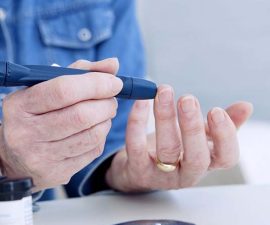Blood sugar (glucose) is one of the most important variables in your metabolism. It’s the main source of your energy. What levels of blood sugar before meal and 1-2 hours after eating are considered normal and abnormal? The answer may vary, depending on whether or not you are diabetic and non-diabetic.
Why is your blood sugar level important?
As the name suggests, blood sugar is sugar (glucose) that circulates in the bloodstream. Glucose is required by the body to make energy to support your activity throughout the day. If you have diabetes, it is easier to rise.
Actually diabetes is harmless, as long as you can control your blood glucose as well! But the problem occurs when your blood glucose level is out of control, causing some serious complications!
Both too high and too low blood sugar is bad for your body. Therefore, it’s important to keep it normal!
For non-diabetics, abnormal level of blood glucose may signal pre-diabetes stage. And for those with diabetes – prolonged, poorly controlled blood glucose can cause serious complications such as: cardiovascular diseases, stroke, nerve damage, kidney failure, retinal problems, and more!
Either lab test or home test for checking blood glucose is blood test. It requires a small amount of your blood, typically taken from a finger. This sample blood is then analyzed, and soon you’ll be informed of the test result.
About A1C test
Alternative names; HbA1c, glycosylated hemoglobin, glycated hemoglobin, and hemoglobin A1C! This blood test is often used to diagnose type-2 and type-1 diabetes. It is also commonly used to help gauge how well diabetics are managing their diabetes.
It can reveal the average blood sugar level in the last 2-3 months. It can specifically measure the percentage of hemoglobin, a substance in your red blood cells that bonds and carries O2 (oxygen), that is coated with glycated (sugar).
The higher level of AIC test result means the higher amount of glucose in the blood, the poorer blood glucose control, and the higher the risk of diabetes complications in diabetics!
For non-diabetics, the A1C level is usually around 4.5 to 6 %. And AIC level of 6.5 % may signal a warning sign of diabetes, it is considered for ‘pre-diabetes’.
The treatment target for people with diabetes is usually 7 % or lower. Diabetics with poorly-controlled blood glucose for a long time might show the A1C test result up to 8 % or even higher.
Differences between mg/dL and mmol/L
Blood glucose level is commonly given in mg/dL or mmol/L. Both describes a measurement of glucose concentration in the bloodstream, but albeit in different ways.
- What is mg/dL? It gives measurement in the ratio of weight to volume. And in this case, it is milligrams per deciliter –or– milligrams per 100 milliliters.
- How about mmol/L? It points to molarity, in which the number of molecules of a substance is measured in a specified volume. In this case, volume is 1 liter. And the substance is glucose!
The use of mg/dL is common in the US and some Europe countries. And for mmol/L, it is commonly used in the UK.
As well we know that measuring blood glucose is now practical. You don’t have to go to the lab, there are many blood sugar test kits you can buy and use at home.
Can you change the units given by your blood test kit? This is dependent on the device. Some devices are designed to display the test result in both sites of units (you can change the units from mmol/L to mg/dL and vice versa) – while others are made to show one set of units! Or you can change it manually, 1 mmol/L is about 18 mg/dL.
Normal blood sugar before eating (fasting)
When you have not eaten for many hours, your blood glucose can drop to its lowest level since there are no dietary sugar you eat and enters into your bloodstream. For such case, it is called fasting blood glucose level.




